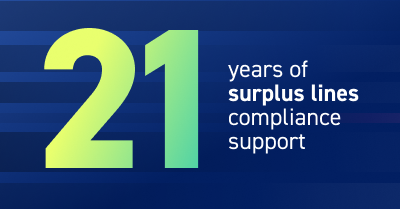Elaine is a Marketing Associate at ReSource Pro Compliance
As you prepare to file a surplus lines policy with state regulators—and, depending on the state, make your premium tax payment—it’s likely you’ll use the declaration (or DEC) page as a convenient source for policy information. For those of you who may be new to the insurance industry, let’s define that term:
Declaration Page – a document appearing at the front of an insurance policy that summarizes information about the insured, the policy period and effective date, the covered risk(s), policy limits, premium amount and fees, and other key information; also called a DEC page, insurance declaration page, or information page
Using the DEC Page for Surplus Lines Filings
Let’s take a closer look at the information required to file surplus lines policies in four key states: California, Florida, New York, and Texas.
California requires a Confidential Report of Surplus Lines Placement (SL-1) and a Diligent Search Report (SL-2). The latter form is not required if the risk appears on the state’s export list. A copy of the policy’s DEC page or a certificate of insurance or binder must accompany these forms. Much of the information needed to complete these forms will appear on the DEC page, including:
- Broker’s or brokerage’s name and surplus lines license number
- Insured’s name and address
- A description of the risk and its location
- The export list or coverage code
- A detailed placement of coverage description, including percentages of premium
Some types of coverage also require additional information.
Florida requires similar forms detailing much of the same information. Here, however, a copy of the declaration page is not required.
Like California, however, New York requires a copy of a coverage document in addition to broker affidavit(s) and a Notice of Excess Line Placement. While New York allows brokers to temporarily use a coverage document other than the declaration page to file a policy, the filing can’t be finalized until it’s submitted.
Finally, in Texas, brokers must supply a DEC page for each item listed on the policy list form which includes:
- Premium amount
- Policy fee amount
- The sum of premium and policy fees
- Surplus lines tax amount
- Stamping fee amount, and
- The sum of all these amounts.
A properly formatted copy of the state stamp language must also appear on the DEC page for paper filings.
Currently, 10 states require a copy of the DEC page to finalize surplus lines filings. Hawaii and Oklahoma only require a copy for cancellations.
The Tricky Part …
Unfortunately, there’s not an industry standard for declaration page formats. They must include certain information, of course; but how that information is organized is up to the carrier. If your agency works with only a few carriers, you’ll quickly learn where to find the information you need. But if you work with lots of different carriers, things may get a little more complicated.
When the DEC Page Isn’t Available
If the DEC page isn’t available within the filing window, many states allow you to file using the binder page or other confirmation of placement of coverage. Remember, though, that when the DEC page is available, you may need to file it with the state as well. In New York, for example, you would submit it as a “stamp only” filing.
Until you submit the DEC page (and any other required documents), the filing isn’t complete. Some states “tag” incomplete filings. You must clear all tags before you can pay the premium taxes and fees.
Need help finding out what information regulators require for surplus lines filings in different states? ReSource Pro’s Surplus Lines Calculator and Tax Tool (CATT) offers immediate access to the state-specific information that brokers need to calculate and pay premium taxes. Our experts can also handle surplus lines filings, premium tax payments, and zero reports for you. Learn more on our Compliance page, or contact us.



